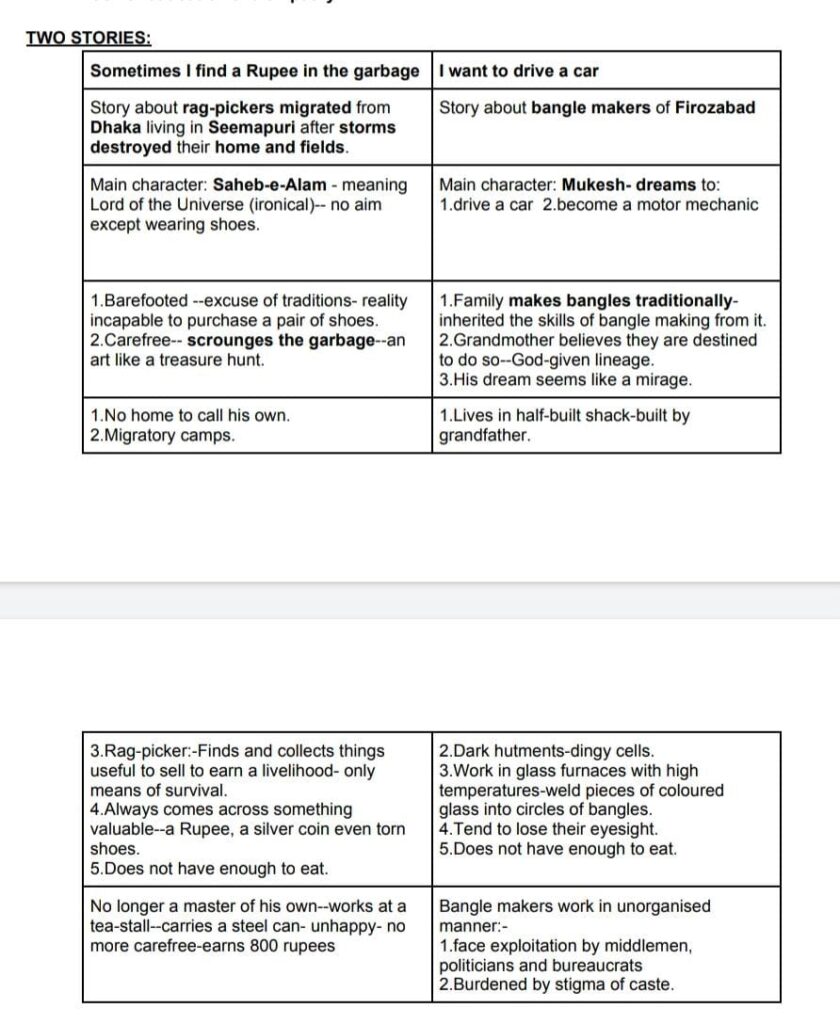Here’s the quick notes for all of you for last minute revision…after revising the notes do attempt the Google form. LINK PROVIDED .GOOGLE FORMS PAGE JOIN MY TELEGRAM GROUP FOR LATEST RESOURCES/STUDY MATERIAL. TELEGRAM CHANNEL.
LESSON -LOST SPRING BY ANEES JUNG class -XII
● metaphor: loss of childhood.
● Tells about: a)conditions of street children forced illegally into labour. b)grinding poverty
and traditions c)denied the opportunity of schooling. d) their exploitation.
● Spring is a symbol of:-.
Title of the chapter : ‘Lost Spring’
a) joy,
b) happiness,
c) beauty,
d) hope and
e) optimism.
● Childhood is spring of a man’s life.
● But lost by millions of children in ragpicking and other hazardous industries.
● Living life full of misery and poverty.
● Lack of education and empathy.

Question Answers:
- Bring out the similarity and contrast between Saheb-e-Alam and Mukesh.
Ans. Sahib-e-Alam and Mukesh are the representatives of needy/ underprivileged and
poor/impoverished section of the society. These children have been denied an education and
forced into hardships early in their lives. Both of them are the victims of the evil of child labour.
They are barely able to make both their ends meet.
Family of Sahib-e-Alam has migrated from Dhaka. His family like many other families of rag pickers
lives in Seemapuri. They do not have other identification other than a ration card. He doesn’t have
any dream.Unlike him, Mukesh lives with his family in a half-built shack owned by his grandfather.
He dreams of becoming a car mechanic someday. - What is the irony in the name Saheb-e-Alam?
Ans. Saheb-e-Alam means the ‘Lord of the Universe’. Contrary to what his name represented,
Saheb roamed the streets with his barefoot friends scrounging the garbage heaps to make both
ends meet. - Is Saheb happy working at the tea stall? Explain.
Ans. No,Saheb is not happy working at the tea stall. Even though he is paid 800 rupees and given
meals but he is no longer his own master. He has lost his carefree look. The steel canister seems to
be heavier than the plastic bag he used to carry for collecting garbage.
4.What forces conspire to keep the workers in the bangle industry of Firozabad in poverty?
OR.
Together they have imposed the baggage on the child that he cannot put down. Explain.
Ans. The workers in the bangle industry of Firozabad like Mukesh are forced to follow the family
tradition do though they earn a meagre amount from it. They are caught in the vicious circle of the
sahukars,middlemen, policemen, politicians and bureaucrats who do not allow them to move out
from it. - Justify the title “Lost Spring”.
Ans. ‘Lost Spring’ is a metaphor used for loss of childhood due to the evil of forced child
labour. Spring is symbolic of joy, happiness, beauty, and hope. Childhood can be called the spring
of a man’s life. However, children like Saheb-e-alam and Mukesh have no spring in their life
Saheb was living a poverty stricken life . He had to work as a rag-picker for earning his livelihood.
He couldn’t enjoy his childhood. Mukesh was also a child who had to work in bangle-making
industry. Bureaucrats forced his family to continue with that work. They couldn’t find the job
according to their interests. In both cases, the children had to do something which the didn’t want
to.In order to survive, they had to do a job since their childhood.So, they weren’t able to enjoy their
childhood. - Garbage to them is gold. How?
Ans.Small children scrounge heaps of garbage. They expect to find some coin, note or valuable
thing in it. Sometimes they find a rupee or even a ten rupee note. This gives the hope of finding
more. They search it excitedly. It provides them items which can be sold for cash, which can buy
them food and is a means of survival. For children, garbage is wrapped in wonder. For the elders it
is a means of survival. Thus garbage to them is Gold

English
Ha
Good
English exam is coming
Awesome 👏..
Useful notes 📝
Great 👏👏👏👏